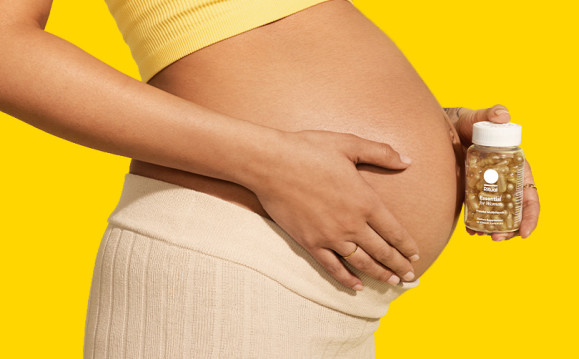Life Stage: 18+
Women: When shopping for a women’s multivitamin (or any dietary supplement, really), it’s important to weigh nutrient needs against what you’re already consuming. As a general rule, supplements are intended to be just that—a supplement to a balanced diet rich in whole foods—rather than a substitute meant to “make up for” a less-than-ideal way of eating. Translation: Nutrient overflow is real, and coupling a food-first approach to nutrition with a streamlined multivitamin can help.
With that caveat out of the way, let’s talk about the nine key nutrients to look for in a women’s multivitamin: folate, omega-3 fatty acids (we use vegan algal oil), vitamin B12, vitamin D3, iron, vitamin K2, boron, vitamin E, and magnesium. (You’ll notice two nutrients missing from that list, and for a reason—vitamin C, found in food sources like citrus fruits along with other fruits and veggies, and calcium, often found in yogurt, chia seeds, and kale.) (1, 2, 3)
We make it easy with just two daily pills of Essential for Women 18+—our clinical-backed multivitamin formulated to help fill nutrient gaps in the diet and support foundational health, including brain health, heart health, bone health, and antioxidant support.*
Men: According to recent data, men have slightly different nutritional needs than women. (Case in point: Guys are falling behind when it comes to certain essential nutrients like magnesium and vitamin A.) Our science team pored over thousands of studies to identify how nutrient needs shift throughout stages of life, including common gaps, genetic considerations, and dietary restrictions, ultimately narrowing the pool to 10 key nutrients men should look for in a multivitamin: vitamin A, zinc, omega-3 DHA, vitamin D (we use vitamin D3), vitamin E, vitamin K2, vitamin B12, folate, magnesium, and boron. (Since non-menstruating people have slightly lower needs when it comes to iron, they can probably meet their recommended intake of the mineral through food alone.)
Designed to support heart health, brain health, normal muscle function, and normal immune function, Essential for Men 18+ contains all of the above, in a delayed-release capsule with a minty-fresh essence. *
Life Stage: 50+
Women: For women who are 50 and older, finding a postmenopausal multivitamin that takes into account specific, evolving nutrient needs is important—after all, what works at age 20 may differ from what works decades down the road. (Iron is a good example of this, along with calcium.) We created our postmenopausal formula with these considerations in mind: Essential for Women 50+ is designed to support healthy aging from within via omega-3 DHA and folate to support brain health; omega-3 DHA to support heart health; calcium-helper nutrients D3, K2, magnesium, and boron to help maintain bone health; and chelated magnesium and vitamin D3 to contribute to muscle protein synthesis.*
Men: As stated, older adults tend to have slightly different nutrient needs than their younger counterparts—and men are no exception. Similar to the making of Essential for Women 50+, we formulated Essential for Men 50+ with these evolving needs in mind, including adjusting dosage amounts to reflect the common dietary gaps that men over 50 experience, as well as providing nutrient support for bone health. Like Essential for Men 18+, it contains vitamin A, zinc, omega-3 DHA, vitamin D3, vitamin E, vitamin K2, vitamin B12, folate, magnesium, and boron—but with slightly higher levels of calcium-helper nutrients magnesium and K2 than our 18+ formula. Learn more here.*











